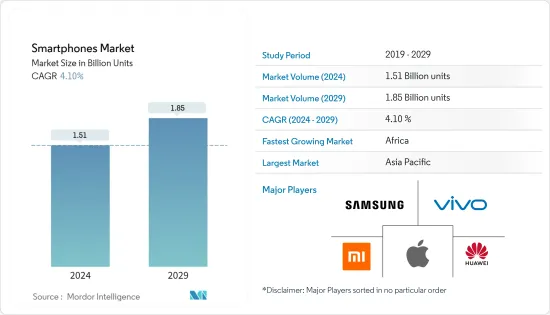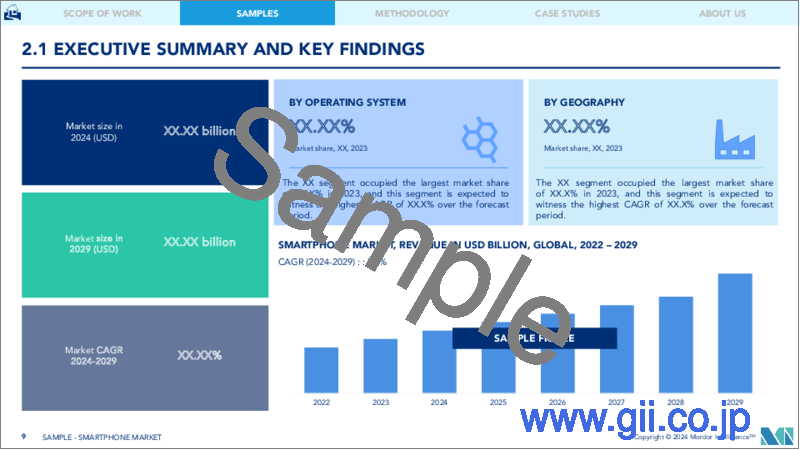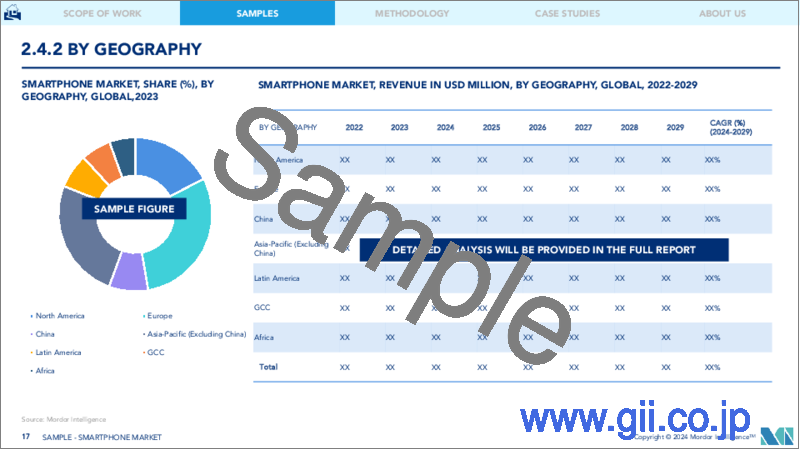|
|
市場調査レポート
商品コード
1438457
スマートフォン: 市場シェア分析、産業動向と統計、成長予測(2024年~2029年)Smartphones - Market Share Analysis, Industry Trends & Statistics, Growth Forecasts (2024 - 2029) |
||||||
|
● お客様のご希望に応じて、既存データの加工や未掲載情報(例:国別セグメント)の追加などの対応が可能です。 詳細はお問い合わせください。 |
|||||||
| スマートフォン: 市場シェア分析、産業動向と統計、成長予測(2024年~2029年) |
|
出版日: 2024年02月15日
発行: Mordor Intelligence
ページ情報: 英文 145 Pages
納期: 2~3営業日
|
- 全表示
- 概要
- 目次
スマートフォン市場規模は2024年に15億1,000万台と推定・予測され、2029年には18億5,000万台に達し、予測期間(2024-2029年)のCAGRは4.10%で成長すると予測されます。

可処分所得の増加、通信インフラの開拓、格安スマートフォンの出現、製品投入の増加などの要因が、アジア諸国のスマートフォン市場成長に寄与しています。
主なハイライト
- スマートフォン産業は着実に発展し、市場規模もモデル数も拡大しています。世界全体では、2021年までに世界人口の40%がスマートフォンを所有するようになります。エリクソンによると、世界のスマートフォン契約数は60億を超え、今後数年間で数億の増加が見込まれています。中国、インド、米国は、スマートフォンユーザー数が最も多い国です。
- コンシューマー・テクノロジー協会(CTA)が実施した「コンシューマー・テクノロジー売上と予測」調査でも、新技術動向に注目し、5G携帯電話の売上は613億7,000万米ドルに達し、2021年の533億8,000万米ドルから15%増加すると予測しています。一方、5Gスマートフォンは2021年には全スマートフォン台数の62%を占め、2022年には72%に上昇すると予想されています。
- 市場の主要企業は、サービス提供の向上と競争力維持のため、戦略的パートナーシップを結んでいます。2022年10月、サムスン電子はスマートホームの相互運用性を高めるためのグーグルとの合意拡大を発表しました。サムスン・ギャラクシーの携帯電話やタブレットのユーザーは、今後数カ月でSmartThingsとGoogle Homeの両エコシステムにマター対応製品を迅速に追加できるようになります。
- 5Gデバイスに対する消費者の関心は高まっています。そのため、チップメーカーはスマートフォンの新ラインアップに5Gチップを搭載するようメーカーに働きかけています。
- 市場の主要ベンダーもネットワークの開拓と拡大に注力しています。例えば、2022年5月、チャイナテレコムとファーウェイの共同記者会見で、新たな革新的5G-Advanced技術であるSuper TimeFreq Foldingが発表されました。チャイナテレコムの劉桂慶副総経理と5G建設ワーキンググループの張新総経理、ファーウェイのキャリアBGのライアン・ディン社長とワイヤレス・ソリューションのガン・ビン副社長が行った基調講演では、このさらなる改良を支える技術とそのラボテストの詳細が議論されました。
- COVID-19の大流行は、スマートフォン市場の需給バランスを大きく崩しました。中国はこれらのデバイスやコンポーネントの大半の世界の製造拠点であり、全国的な封鎖により、スマートフォン製造部門は出荷の遅れや次世代製品の開発の弱体化によって悪影響を受けました。また、サプライヤー、労働者、物流網が遮断されているのも目の当たりにしました。さらに、消費者のスマートフォンに対する需要、特にプレミアム・セグメントに対する需要は、パンデミックの影響で顧客が贅沢な支出を控え、必需品に集中する傾向にあるため、減少しました。
- スマートフォンは現在、製品コストの低下、携帯端末のデザインと機能の向上、世界なモバイル電子メールおよびブラウジング・サービスの拡大、4Gおよび5Gネットワーク技術の出現、携帯通信事業者間の競争激化、オペレーティング・システムの標準化とアップグレードなど、さまざまな要因の結果、急成長を遂げています。
- スマートフォンは、コロナが大流行した際に非常に重要な役割を果たしたが、これは大流行が収束した後も続き、ほとんどすべての政府サービス、医療、教育、金融サービスなどがオンライン化され、スマートフォンはこれらのサービスにアクセスするための、よりアクセスしやすく、より手頃なゲートウェイとしての役割を果たしました。
スマートフォン市場動向
アンドロイドOSが大きく成長する見込み
- 2022年1月に発表されたStatCounterのレポートによると、Androidは依然として世界で最も人気のあるモバイル・オペレーティング・システムであり、iOSが市場の約25%を占めるのに対し、市場シェアは70%近くに達しています。
- さらに、多くのアプリケーション開発者は、C++、Kotlin、Javaなどの言語を開発者が知っている必要があるため、ゲーム/エンターテイメントアプリケーション、ソーシャルメディアアプリケーション、モバイルユーティリティアプリケーション、ライフスタイルアプリケーションの開発にAndroid OSを好んでいます。さらにグーグルは、Android Jetpack、Firebase、AndroidSDKといった様々な開発ツールを提供し、開発者が直感的なインターフェースを構築できるよう支援しています。
- さらに、このプラットフォームでは、ユーザーは無料でアプリケーションをダウンロードできます。しかし、アプリケーションは、アプリ内課金やアプリ内コースの購読を提供するように設計されており、アップルストアよりもグーグルプレイストアでより多くの収益を上げています。例えば、Airnow PLCによると、2021年4月にコインマスターがGoogle Playストアを通じて生み出した収益は約6,102万米ドルでした。これに続くのが、2021年4月に3,856万米ドル、3,776万 米ドルの収益を上げた「GarenaFree Fire-World」シリーズと「PUBG Mobile-Karakin」です。
- エネルギー管理やスマートホーム製品など、統合IoT(モノのインターネット)アプリケーション向けの高速データ接続に対する需要の増加は、5Gスマートフォンの採用を促進すると予想されます。
- OPPOは2022年2月、5Gに対応したFind X5シリーズを発表し、スマートフォンの画像処理と豪華なデザインの水準を引き上げました。Find X5シリーズには業界をリードする機能が満載され、クリーンで現代的な洗練と重要な画像体験を実現する未来的なスタイルを提供しています。これには専用の画像ニューラル処理ユニットが含まれ、夜間録画というスマートフォンの動画撮影における最も困難な課題に対処しています。
アジア太平洋地域が大きな市場シェアを占める見込み
- アジア太平洋地域はスマートフォンの重要な市場のひとつであり、その主な理由は、高度に発展している通信セクターと大規模な顧客基盤にあります。さらに、同地域ではモバイルネットワークへの投資も活発化しています。インド、日本、オーストラリア、シンガポール、韓国などの国々は、国内通信市場の開拓にますます投資しており、このことも同地域の市場を牽引すると予想されます。
- エントリーレベルの価格帯のスマートフォンに対する需要は、インドやインドネシアといった新興経済諸国からの需要が増加しており、地方政府がデジタル経済やモバイル経済を推進しているため、スマートフォンが地方に浸透しつつあることが要因として予想されます。例えば、デジタル・インディア・プログラムは、同国をデジタル・エンパワーメントされた社会に変革することを主目的とするインド政府の旗艦プログラムです。
- さらに、インドではPLIスキームが開始され、2019年から2020年にかけて製造された携帯電話の販売増に対して5年間6~4%のインセンティブが提供されました。ハイエンドの多国籍携帯電話メーカー、つまり200米ドル以上の携帯電話端末を製造しているメーカーは、昨年度に490万米ドル相当の商品を販売し、奨励金を請求しなければならなかった。政府によるこのような取り組みは、同国のスマートフォン市場を押し上げると期待されています。
- スマートフォン市場の主要ベンダーは、製品ラインナップの充実と、この地域全体への新製品の投入に注力しています。例えば、2022年9月、アップルはiPhone 14 ProとiPhone 14 Pro Maxの発売を発表しました。同製品は、Always-Onディスプレイ、iPhone史上初の48MPカメラ、衝突検知、衛星経由の緊急SOS、Dynamic Islandによる通知やアクティビティの革新的な新しい受信方法などを特徴としていました。
- 都市人口の増加、モバイル機器の使用に関する消費者の意識の高まり、AR技術の急速な統合、オーバー・ザ・トップ(OTT)プラットフォームの契約拡大が、今後数年間の市場拡大を促進すると予想されます。
- 中国本土では、スマートフォンの普及が進み、4Gが利用可能になったことで、モバイルインターネット利用が急増し、デジタル社会のバリューチェーンにおける同国の動きを支えています。9億9,000万人以上がモバイル・インターネット・サービスを利用しており、2025年までに2億人増加すると予想されています。
スマートフォン業界の概要
スマートフォン市場は競争が激しく、Samsung、Huawei、Apple、 Xiaomiなどの既存企業が独占しています。これらの企業の大半は、バッテリーパワー、カメラ構成、プロセッサーなどの小さな技術変更を伴う新モデルを発表し続けています。
2022年10月、Samsung Electronicsは、クラウドネイティブの5Gマクロ・コアと無線アクセス・ネットワーク(RAN)を含む自社のネットワーク・ソリューションにより、NTT東日本のプライベート5Gネットワークの成長をサポートし、日本の複数の業界にわたる企業向けの新しく多様なユースケースを可能にすることに成功したと述べた。
Huaweiは2022年10月、MaxwellプラットフォームやX2アンテナシリーズなど、5Gアンテナ進化の次のフェーズに向けた最新のアンテナソリューションを発表しました。新技術はアンテナの統合とセットアップ機能を強化し、通信事業者が5Gをより迅速に展開できるようにします。
その他の特典:
- エクセル形式の市場予測(ME)シート
- 3ヶ月間のアナリストサポート
目次
第1章 イントロダクション
- 調査の前提条件と市場定義
- 調査範囲
第2章 調査手法
第3章 エグゼクティブサマリー
第4章 市場洞察
- 市場概要
- 業界の魅力度-ポーターのファイブフォース分析
- 供給企業の交渉力
- 買い手の交渉力
- 新規参入業者の脅威
- 代替品の脅威
- 競争企業間の敵対関係の強さ
- スマートフォン業界のバリューチェーン分析
- COVID-19の市場への影響評価
第5章 市場力学
- 市場促進要因
- 5Gデバイス、サービス、技術の登場
- 新興市場における需要の増加
- 市場抑制要因
- 需要の停滞
- 市場機会
- 市場の技術情勢
- スマートフォン端末のライフサイクル分析
- 利害関係者を通じたライフサイクル
- デバイスのライフサイクルを通じた利害関係者の主なペインポイント分析
- スマートフォン端末のライフサイクル分析
- 技術ロードマップ分析
第6章 市場セグメンテーション
- OS別
- android
- iOS
- 地域別
- 北米
- 欧州
- 中国
- アジア太平洋(中国を除く)
- ラテンアメリカ
- GCC
- アフリカ
第7章 競合情勢
- 企業プロファイル
- Samsung Electronics Co. Ltd
- Huawei Technologies Co. Ltd
- Apple Inc.
- Xiaomi Corporation
- BBK Electronics Corporation(Vivo, Realme, Oppo, and OnePlus)
- Lenovo Group Limited
- HTC Corporation
- HMD Global Oy
- Sony Corporation
- ZTE Corporation
- Google LLC
第8章 ベンダー市場シェア
第9章 競合ベンチマーキング分析
第10章 投資分析
第11章 投資分析市場の将来
The Smartphones Market size is estimated at 1.51 Billion units in 2024, and is expected to reach 1.85 Billion units by 2029, growing at a CAGR of 4.10% during the forecast period (2024-2029).

Factors such as increasing disposable income, the development of telecom infrastructure, the emergence of budget-centric smartphones, and an increasing number of product launches contribute to the smartphone market growth in Asian countries.
Key Highlights
- The smartphone industry has been steadily developing and growing in market size and models. Globally, 40% of the world's population owned a smartphone by 2021. According to Ericsson, the number of smartphone subscriptions worldwide surpasses six billion and is expected to grow by several hundred million in the next few years. China, India, and United States are the countries with the highest number of smartphone users.
- The Consumer Technology Sales and Forecast study conducted by the Consumer Technology Association (CTA) also looked at new technology trends, projecting that 5G cellphones would generate USD 61.37 billion in revenue, up by 15% from USD 53.38 billion in 2021. Meanwhile, 5G smartphones are expected to account for 62% of all smartphone units in 2021, rising to 72% in 2022.
- The key players in the market are involved in strategic partnerships to improve their service offerings and remain competitive. In October 2022, Samsung Electronics announced an expanded agreement with Google to advance smart home interoperability. Users of Samsung Galaxy phones and tablets will be able to quickly add Matter-compatible products to both the SmartThings and Google Home ecosystems in the coming months.
- Consumer interest in 5G devices is growing. Thus, chipmakers are pushing manufacturers to include 5G chips in their new smartphone lineup.
- Key vendors in the market are also focusing on network development and expansion. For instance, in May 2022, Super TimeFreq Folding, a new innovative 5G-Advanced technology, was launched during a joint press conference by China Telecom and Huawei. The technology underpinning this further improvement, as well as the specifics of its lab testing, were discussed during keynote addresses delivered by China Telecom's Deputy General Manager Liu Guiqing and 5G Construction Working Group's General Manager Zhang Xin, as well as Huawei's Carrier BG's President Ryan Ding and Wireless Solution's Vice President Gan Bin.
- The COVID-19 pandemic severely disrupted the smartphone market's balance between supply and demand. Since China is the global manufacturing center for most of these devices and components, and with the nationwide lockdown, the smartphone manufacturing sector has been adversely hit by delayed shipments and weakened development of next-generation products. The country also witnessed being choked off by suppliers, workers, and logistics networks. Moreover, consumer demand for smartphones, especially in the premium segment, declined due to customers' tendency to cut down on luxury spending and focus on essentials due to the pandemic.
- Smartphones are currently experiencing rapid growth as a result of a variety of factors such as lower product costs, improved handset design and functionality, the expansion of global mobile email and browsing services, the emergence of 4G and 5G network technologies, rising competition among mobile carriers, and the standardization and upgrading of operating systems.
- Smartphones played an incredibly important role amid the widespread corona pandemic, and this continued even after the pandemic was over, as almost all government services, health, education, financial services, and so on went online, with smartphones serving as a more accessible and more affordable gateway to access these services.
Smartphone Market Trends
Android Operating System is Expected to Grow Significantly
- According to a StatCounter report released on January 2022, Android remained the world's most popular mobile operating system, with a market share of close to 70%, while iOS accounted for roughly 25% of the market.
- Furthermore, many application developers prefer Android OS to develop gaming/entertainment applications, social media applications, mobile utility applications, and lifestyle applications, as it requires the developers to know languages such as C++, Kotlin, and Java, among others. Moreover, Google also offers various development tools, such as Android Jetpack, Firebase, and AndroidSDK, to assist developers in building a user-intuitive interface.
- Additionally, the platform allows users to download applications free of cost. However, the applications are designed to offer in-app purchases and in-app course subscriptions that have generated more revenue in Google Play Stores than in Apple Stores. For instance, according to Airnow PLC, the revenue generated by coin master in April 2021 was approximately USD 61.02 million through Google Play Stores. This was followed by the GarenaFree Fire- World series and PUBG Mobile-Karakin, which generated a revenue of USD 38.56 million and 37.76 million in April 2021.
- The increasing demand for high-speed data connectivity for integrated IoT (Internet of Things) applications, such as energy management and smart home products, is anticipated to propel the adoption of 5G smartphones.
- In February 2022, OPPO unveiled its Find X5 Series with 5G support, which raises the bar for smartphone imaging and luxurious design. Find X5 Series brims with industry-leading features and offers a futuristic style that achieves clean, modern sophistication and significant imaging experiences. These include a dedicated image neural processing unit, which addresses the most challenging barrier of smartphone video capture of nighttime recording.
Asia-Pacific is Expected to Hold a Significant Market Share
- The Asia-Pacific region is one of the significant markets for smartphones, primarily owing to the highly developing telecom sector and large customer base. Furthermore, the region is increasingly investing in the mobile network. Countries such as India, Japan, Australia, Singapore, and South Korea, are increasingly investing in developing the domestic telecom market, which is also expected to drive the market in the region.
- The demand for smartphones at the entry-level price points is expected to be driven by the increasing demand from the developing countries in the region, such as India and Indonesia, where smartphones are increasingly penetrating into the rural areas as local governments are pushing for digital and mobile economy. For instance, the Digital India program is a flagship program of the Government of India primarily aimed at transforming the country into a digitally empowered society.
- Moreover, India had also launched the PLI Scheme, which offered a 6-4% incentive for five years on incremental sales of manufactured handsets over 2019-2020. High-end multinational cell phone makers, or those producing handsets worth over USD 200, had to sell goods worth USD 4.9 million in the last financial year claim the incentives. Such initiatives by the government are expected to boost the smartphone market in the country.
- The key vendors in the smartphone market are focusing on improving their product offerings and introducing new products across this region. For instance, in September 2022, Apple announced the release of the iPhone 14 Pro and iPhone 14 Pro Max. It featured the Always-On display, the first-ever 48 MP camera on an iPhone, Crash Detection, Emergency SOS via satellite, and an innovative new way to receive notifications and activities with the Dynamic Island.
- The rise in the urban population, increased consumer awareness regarding mobile device usage, the surging integration of AR technology, and expanding over-the-top (OTT) platform subscriptions are expected to drive the market's expansion in the coming years.
- In mainland China, rising smartphone adoption and the availability of 4G have resulted in a surge in mobile internet usage that supports the country's movement up the digital-society value chain. More than 990 million people use mobile internet services, which is expected to increase by 200 million by 2025.
Smartphone Industry Overview
The smartphones market is a highly competitive market, dominated by established players such as Samsung, Huawei, Apple, and Xiaomi, among others. Most of these players keep launching new models with small technology changes such as battery power, camera configuration, and processor.
In October 2022, Samsung Electronics stated that it successfully supported NTT East's private 5G network growth with its network solutions, including the cloud-native 5G Macro Core and Radio Access Network (RAN), enabling new and diverse use cases for corporations across multiple industries in Japan.
In October 2022, Huawei announced the launch of the latest antenna solutions for the next phase of 5G antenna evolution, including the Maxwell platform and the X2 antenna series. The new technologies enhance antenna integration and setup capabilities, allowing carriers to deploy 5G more quickly.
Additional Benefits:
- The market estimate (ME) sheet in Excel format
- 3 months of analyst support
TABLE OF CONTENTS
1 INTRODUCTION
- 1.1 Study Assumptions and Market Definition
- 1.2 Scope of the Study
2 RESEARCH METHODOLOGY
3 EXECUTIVE SUMMARY
4 MARKET INSIGHTS
- 4.1 Market Overview
- 4.2 Industry Attractiveness - Porter's Five Forces Analysis
- 4.2.1 Bargaining Power of Suppliers
- 4.2.2 Bargaining Power of Buyers
- 4.2.3 Threat of New Entrants
- 4.2.4 Threat of Substitute Products
- 4.2.5 Intensity of Competitive Rivalry
- 4.3 Smartphones Industry Value Chain Analysis
- 4.4 Assessment of the Impact of COVID-19 on the Market
5 MARKET DYNAMICS
- 5.1 Market Drivers
- 5.1.1 Launch of 5G Devices, Services, and Technologies
- 5.1.2 Increasing Demand in the Emerging Markets
- 5.2 Market Restraints
- 5.2.1 Stagnating Demand
- 5.3 Market Opportunities
- 5.4 Technology Landscape of the Market
- 5.4.1 Smartphone Device Lifecycle Analysis
- 5.4.1.1 Lifecycle Through Stakeholders
- 5.4.1.2 Key Pain-point Analysis of Stakeholders Throughout the Device Lifecycle
- 5.4.1 Smartphone Device Lifecycle Analysis
- 5.5 Technology Roadmap Analysis
6 MARKET SEGMENTATION
- 6.1 By Operating Segment
- 6.1.1 Android
- 6.1.2 iOS
- 6.2 By Geography
- 6.2.1 North America
- 6.2.2 Europe
- 6.2.3 China
- 6.2.4 Asia-Pacific (Excluding China)
- 6.2.5 Latin America
- 6.2.6 GCC
- 6.2.7 Africa
7 COMPETITIVE LANDSCAPE
- 7.1 Company Profiles
- 7.1.1 Samsung Electronics Co. Ltd
- 7.1.2 Huawei Technologies Co. Ltd
- 7.1.3 Apple Inc.
- 7.1.4 Xiaomi Corporation
- 7.1.5 BBK Electronics Corporation (Vivo, Realme, Oppo, and OnePlus)
- 7.1.6 Lenovo Group Limited
- 7.1.7 HTC Corporation
- 7.1.8 HMD Global Oy
- 7.1.9 Sony Corporation
- 7.1.10 ZTE Corporation
- 7.1.11 Google LLC




